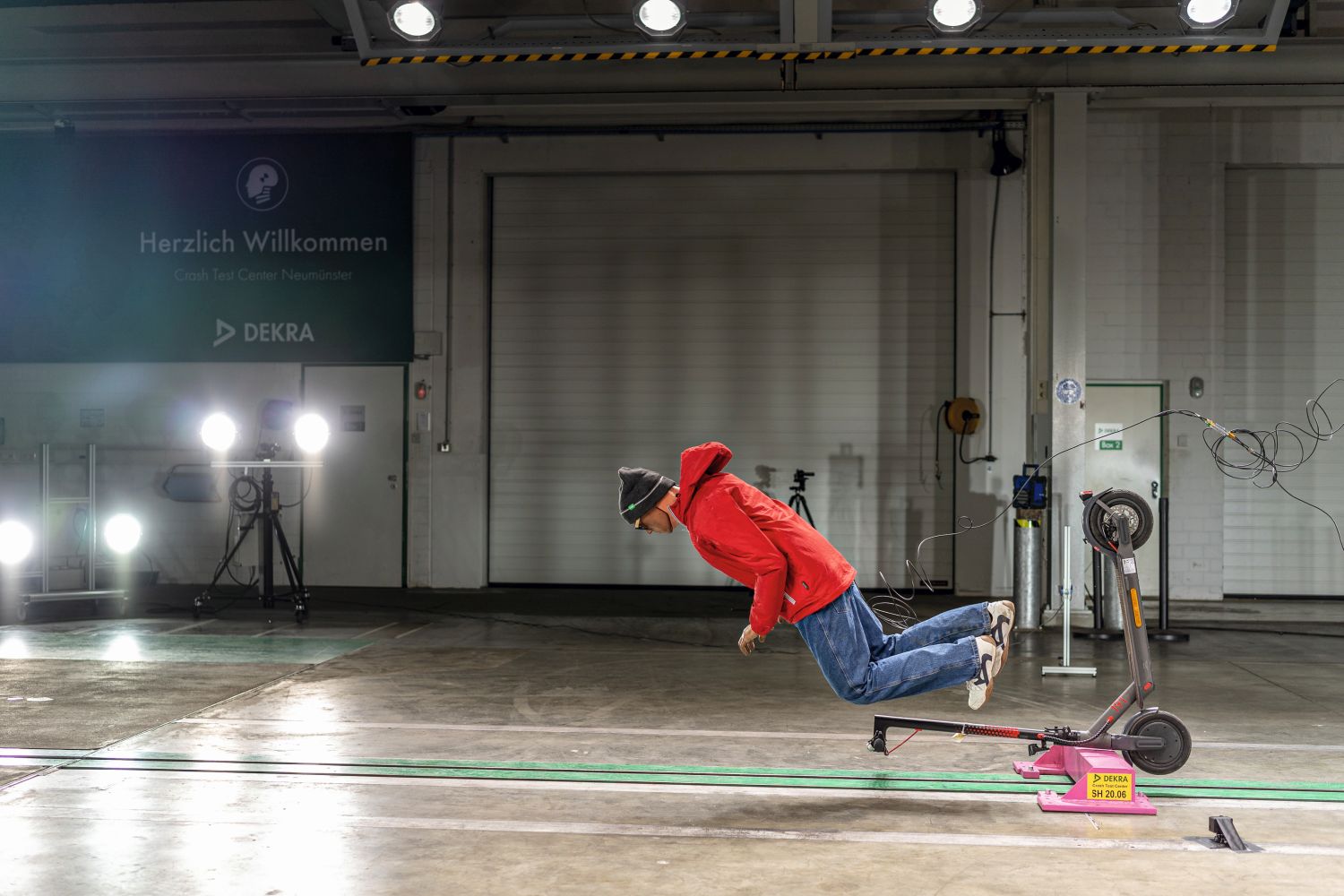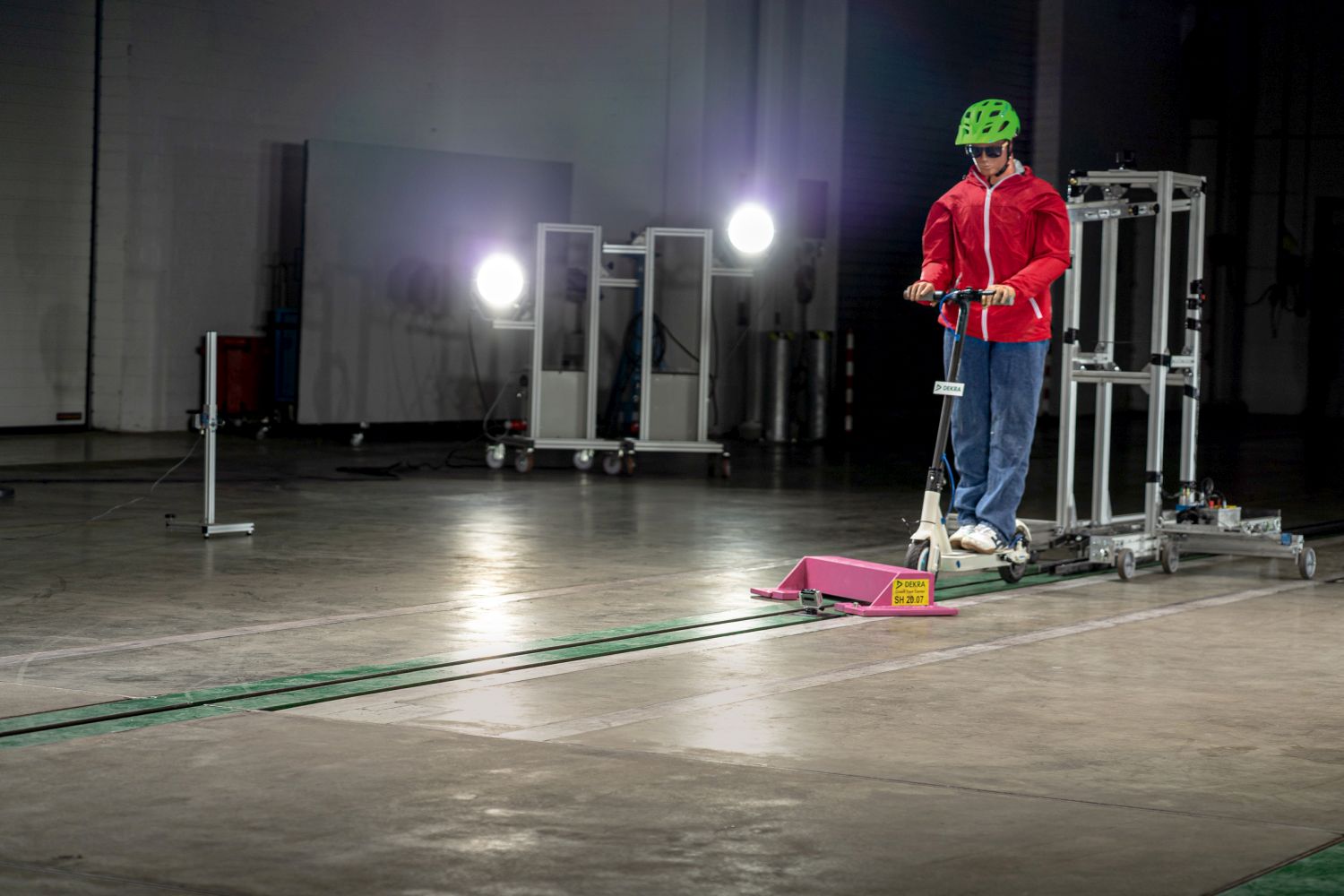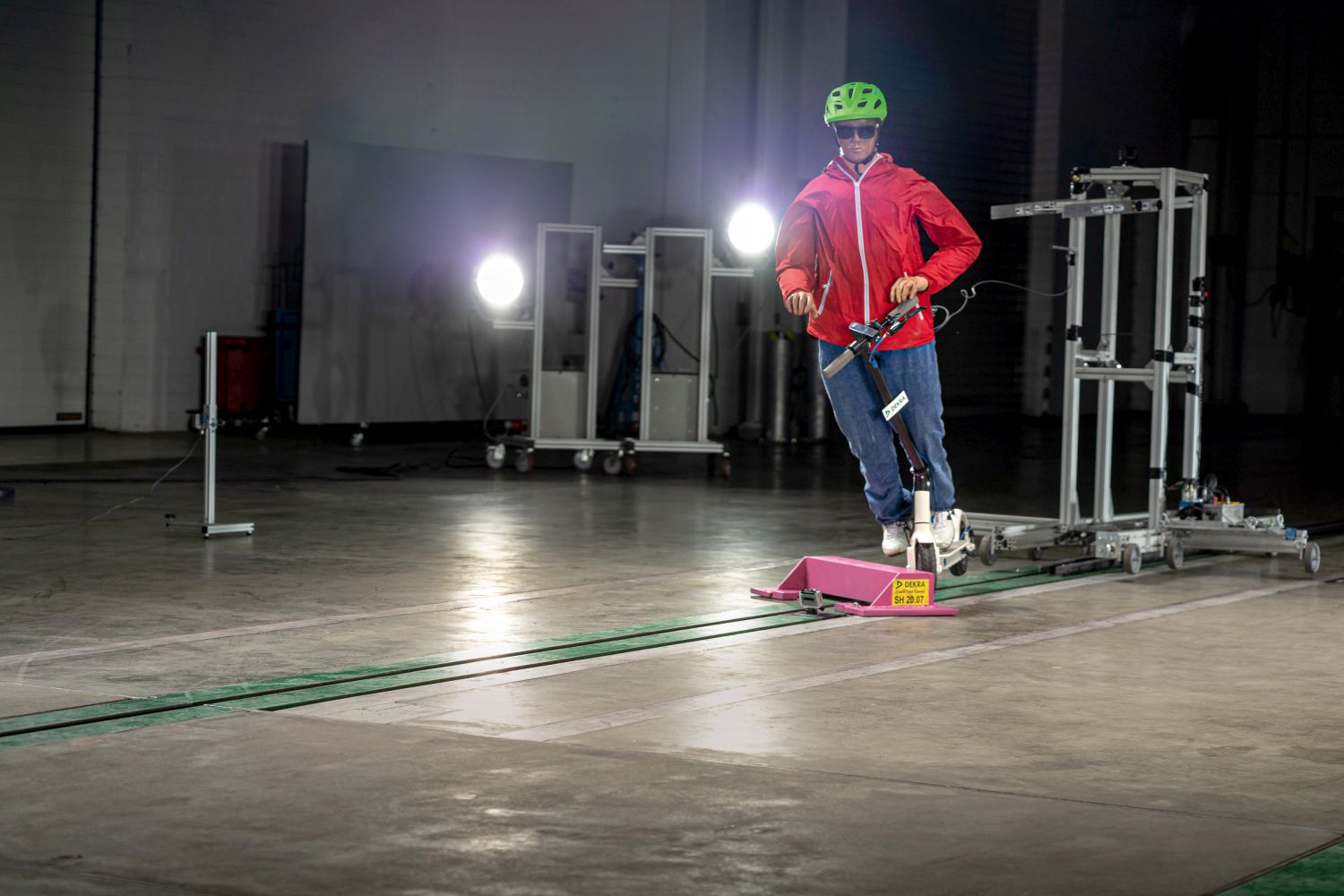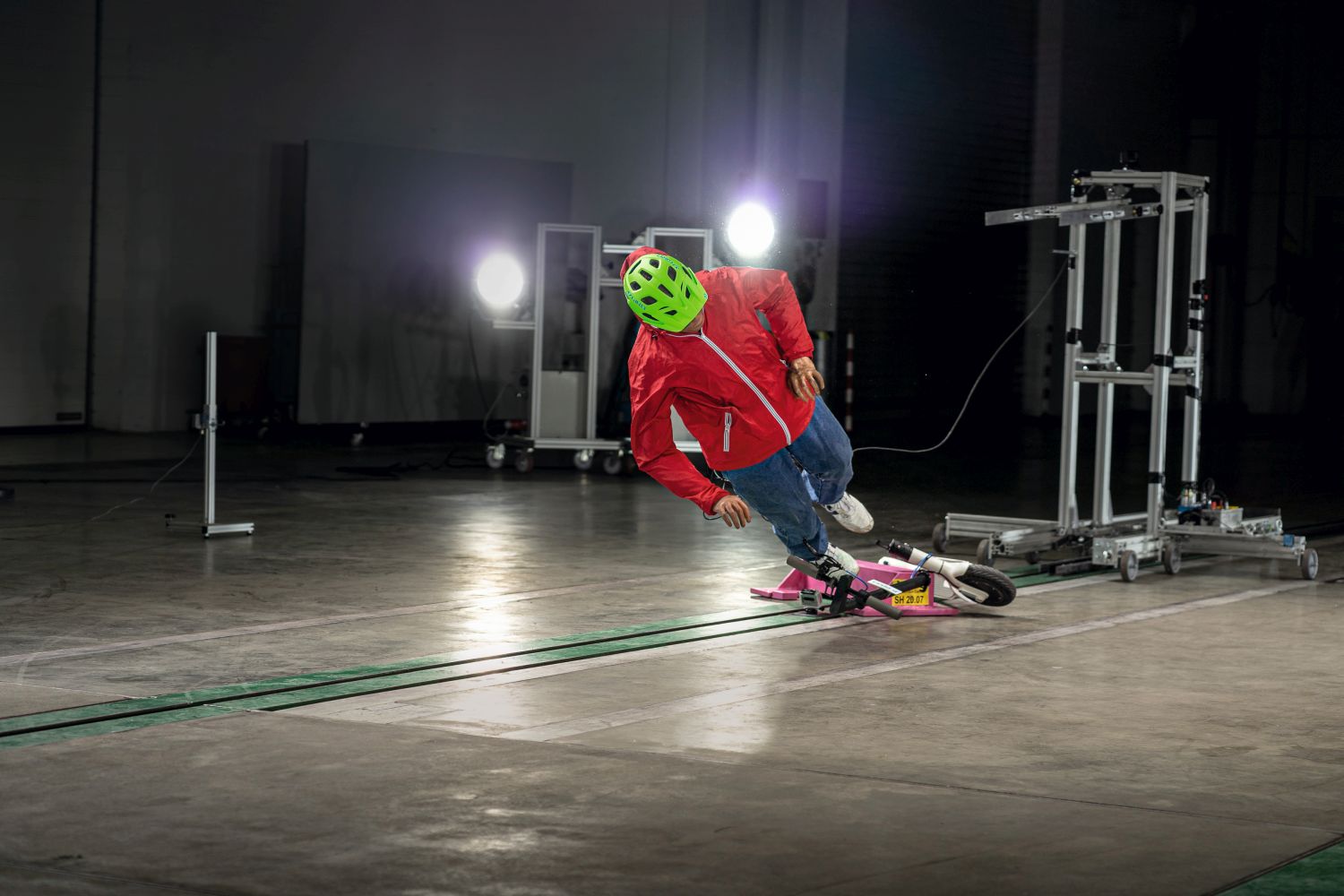Crash Test: When the Worst Comes to the Worst
Author: Ralf Johanning
The DEKRA Crash Test Center in Neumünster is rarely open to the public. Most tests on behalf of the clients are often highly confidential. In addition to conventional passenger cars, vehicles with alternative drive systems are officially tested at this ultra-modern facility.
A nervous silence fills the DEKRA Crash Test Center Neumünster. Almost all of those present are anxiously asking themselves “Will the test go as planned?” It has taken almost an hour to affix sensors to the crash test dummy and perfectly mount it onto an electric scooter, meticulously ensuring that it mirrors reality as closely as possible. Suddenly, the traction cable whirrs into action, and the e-scooter is accelerated to 20 kilometers per hour along a guide rail, before ultimately crashing front-on into the curb. The dummy flies over the handlebars and lands on the ground a good meter beyond the curb in a heap. “Wow, now that’s what I call a jump,” quips Peter Rücker, Head of Accident Research at DEKRA. The result reveals that although riders may think they look cooler without a helmet, a hat and sunglasses do nothing to protect the head in the event of a fall. “In this case, the forces exerted on the head were clearly outside permissible limits, which could spell irreversible head injuries,” explains Rücker.
Detailed results in the Road Safety Report
For the experts at DEKRA, these are important insights that will be incorporated into the current DEKRA Road Safety Report 2020, which will be published later this year. At the DEKRA Crash Test Center in Neumünster, it isn’t just the expert organization that can test hazards faced by people traveling on two or four wheels. The facility in northern Germany is also the go-to for many vehicle manufacturers seeking to test their prototypes and pre-production models, in order to gather the test reports necessary to obtain national and international approval.
To this end, the site offers complete prototype protection through an electronic access system that prevents unauthorized entry. Customers can prepare their trials in fully-equipped offices, while an unloading lock and separate, temperature-controlled starting box further protect manufacturers’ prototypes. “The public rarely has the opportunity to see a crash here. Most of the tests here are performed in secret. Everything is geared towards ensuring this. Only when we carry out crashes for DEKRA Accident Research or for the press under our own direction is there the possibility of a public audience,” explains Thilo Wackenroder, Director of the DEKRA Crash Test Center. These e-scooter crash tests are one of those rare occasions.
A helmet prevents a worse outcome
The crash dummy, this time wearing a helmet, is finally prepared for its second test on the e-scooter. Now, the DEKRA accident experts are looking to discover what effects wearing a protective helmet has, and how the impact behavior of the dummy changes when the e-scooter hits the curb at an angle. Once again, the e-scooter is accelerated and collides with the curb. The dummy is launched, and lands roughly on the concrete. Its sunglasses are catapulted off and the sun visor of the helmet is also ejected away. This fall would also be very painful for the rider, yet the helmet prevented worse injury. The impact forces exerted on the head remain in the moderate range.
Between 150 and 180 times each year, the experts in Neumünster assess test vehicles against all prevailing national and international standards for vehicle minimum safety requirements, such as the European ECE, the American FMVSS or the Japanese TRIAS. The center in Neumünster also performs crash tests for passenger safety, in line with standards such as EuroNCAP, US-NCAP and further international consumer standards. The professionals use a multitude of different sensors in every test, which, depending on the application, can each be rigged up with up to 50 measurement channels. They precisely record the effects on the dummies in the cases of front-on and side-on impacts.


To log accurate results, cars can also be rigged with up to 200 sensitive sensors that record the behavior of the vehicle. This allows the professionals to acquire precise multidimensional data. In addition, several high-speed cameras are set up for each experiment, recording the process in great detail. In Neumünster, the cameras can also be positioned in a pit below the point of impact in order to record the crash behavior from all angles. The automated hydrostatic drive system is capable of accelerating vehicles weighing up to 2.5 metric tons and with a vehicle height of 4 meters up to 90 kilometers per hour along the 102-meter approach track. For vehicles weighing up to 3.5 tons, the system can attain speeds of 80 kilometers per hour. For the various tests, the facility has a 120-metric-ton collision rig that can be rotated through 360 degrees. This enables the simulation of frontal, side and even tree collisions. If required, an outdoor crash system can operate at even higher speeds or higher vehicle weights.
DEKRA has also been testing vehicles with alternative drives at this facility for several years. To enable this, the expert organization was required to fulfil a range of technical and regulatory requirements to mitigate additional fire risks, including installing a purpose-built CO2 fire extinguishing system. This is because vehicles featuring gas or hydrogen drivetrains present a particular fire risk. All of this means that DEKRA in Neumünster will continue to be the first port of call for any vehicle requiring a crash test.
The DEKRA Crash Test Center Neumünster
Indoor
- Approach Track: 102 m
- Speed Thresholds: between 4 and 80 km/h for vehicles up to 3.5 metric tons; 90 km/h for vehicles up to
- 2.5 metric tons
- Accuracy: +/- 0.2 % up to 80 km/h
- Film Pit: 16 m x 2.5 m x 3.5 m
- Collision Rig: 3 m x 3 m x 2 m and 120 metric tons; rotatable through 360 degrees
Outdoor
- Approach Track: 107 m
- Speed Thresholds: between 5 and 120 km/h; up to 44 km/h for vehicles up to 40 metric tons
- Accuracy: +/- 0.5 %
- 2 Film pits measuring 6 m x 0.9 m x 3 m
- Collision Rig: 500 metric tons; 4 m x 4 m x 5 m



